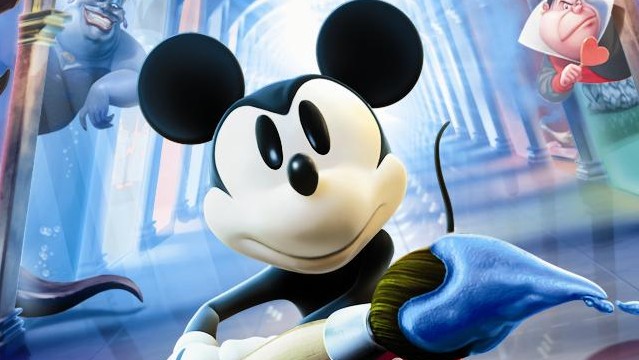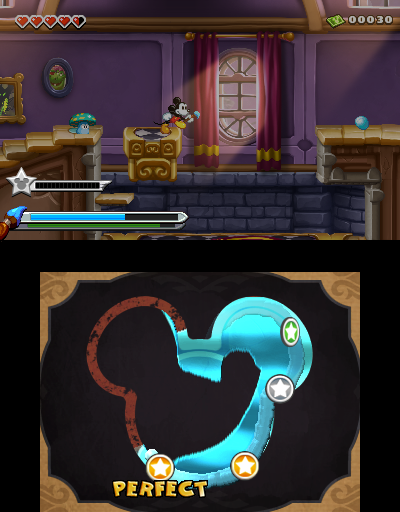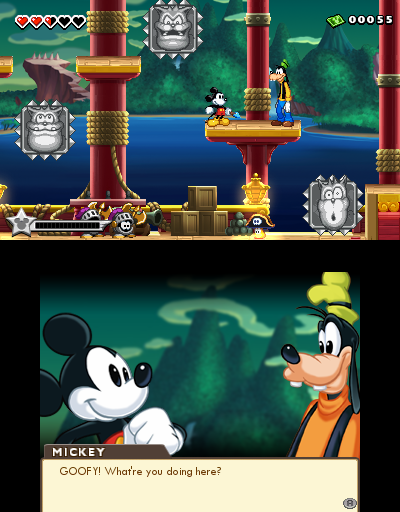
When Warren Spector took the stage at Disney’s special preview event for Epic Mickey: Power of Illusion, he told the audience of the unique challenge he faced when he first laid eyes on the 3DS. The hardware itself was certainly appealing, but how, exactly, would he go about designing a game for it? It was clear, given Junction Point’s involvement in Epic Mickey 2: The Power of Two, that he would need a development partner to take up the project’s reins, but who would the right partner be, and how would they use the system in an innovative way?
The answer, it turns out, would come from DreamRift, a little Florida-based developer that was quickly making a name for itself with its creative handheld titles. DreamRift approached Spector with an interesting gameplay idea: players would be able to draw an object on the 3DS touch screen, and whatever it is they draw would then materialize in the world on the top screen. Spector immediately liked the pitch, and thus the idea for Epic Mickey: Power of Illusion was born.
The pairing of this idea with the Epic Mickey world was fortuitous for a number of reasons, not least because of how well it lends itself to this type of gameplay. Painting and thinning were central components in both the first Epic Mickey and its upcoming sequel, so it only made sense to utilize them once again for the 3DS game. DreamRift’s pitch also offered a clever workaround to just how to incorporate these elements into a handheld title, using the console’s strengths– namely the ability to physically draw an object using the stylus– to great effect.

Tracing objects on the touch screen will let Mickey summon them on the top one.
Perhaps more importantly, the pairing also gives creative director Peter Ong a chance to express his love of the classic Genesis game Castle of Illusion, which serves as the primary inspiration for Power of Illusion‘s own gameplay and storyline. Like the first Epic Mickey, the plot in Power of Illusion revolves around the Wasteland, a world made up of forgotten Disney characters and attractions. This time, however, the Castle of Illusion itself appears in the Wasteland, and with it the evil, shape-shifting witch Mizrabel, who has abducted a number of popular Disney characters– including the ever-hapless Minnie Mouse– and is using their life force to return to the real world. Oswald tells Mickey of the castle’s appearance, and the brave little mascot ventures forth to rescue his friends… but not before stopping by Yen Sid’s workshop to retrieve his magical paintbrush.
After this brief detour, players meet up with Jiminy Cricket, who acts as Mickey’s travel companion throughout the game, and begin the adventure proper. Each level in Power of Illusion is divided up into sub-stages, and takes place in its own dedicated wing of the castle, which is based on a classic Disney film (the first level, for instance, takes players through the world of Peter Pan, while another, which was revealed for the first time at the preview event, is based on Aladdin). The further players travel into each wing, the more convincing its illusions become– you’ll notice each sub-stage gradually morphing to reflect its theme as you make your way through the castle– until you encounter the boss battle at the end.
Each level is also littered with the characters Mizrabel abducted, who Mickey can rescue simply by finding them. Once rescued, these characters will then convene in the Fortress, a safe house of sorts that’s located inside of the castle. Here players can further interact with the characters in between stages, taking on unique side quests and upgrading each of their rooms as they see fit. The more quests you complete, the better the rewards you’ll earn, and the sheer variety of characters you’ll meet in the course of your adventure (DreamRift has said that Power of Illusion’s cast will be drawn from the full spectrum of Disney’s history, from its very beginning to characters as recent as Rapunzel in Tangled) ensures that completists will be busy with the game for a long time to come.

You’ll meet a ton of familiar faces in your quest through the Castle of Illusion.
Like in previous Epic Mickey titles, Mickey has the ability to draw and erase objects using his magical paintbrush. But rather than doing so at will and dealing with the ramifications of his decisions (as was the case in the original Wii title), he is now restricted to painting and thinning specific objects, which will appear as silhouettes on the bottom screen. Tapping the silhouette will pull up an outline of that object, which you must trace as quickly and as accurately as possible to “paint” it into existence. You’ll also get a brief power boost depending on how well you drew the object, allowing Mickey to run faster and jump higher for a short period of time. This mechanic also adds a nice puzzle element to the game, as players will have to figure out on the fly (particularly in later stages, after you have become acclimated with its gameplay) which items to draw and which to erase in order to progress through a level.
The game’s controls are also very tight. Mickey moves at a more deliberate pace than Mario, lacking the latter’s quickness and agility, but his speed is perfectly suited to the game’s rhythm; there are no nerve-wracking jumps to make, and enemies patrol each stage with the same measured gait. He’s also much more versatile than the plumber is; in addition to the standard jump attack (which can send the mouse high into the air when timed correctly), Mickey can also perform a spin attack, shoot paint at obstacles, and even has a higher degree of control while airborne, allowing him to arc his leaps with a level of precision that Mario can only dream of. He also has access to special items called sketches, which allow him to summon specific objects and characters at will. These sketches function similarly to the game’s other paintable objects, but with the added benefit of being inventory items, allowing you to take them into any stage you wish.
While I’ve only sampled a small portion of Epic Mickey: Power of Illusion, I left Disney’s preview event looking forward to the next time I can get my hands on the game. The title looks to offer a unique take on the Epic Mickey gameplay, repurposing the paint/thin dichotomy that fueled the original while paying tribute to the 16-bit platformers of yore. And that’s nothing to say of its gorgeous visuals, which perfectly marry the aesthetics of Castle of Illusion with the console’s stereoscopic ability. Even if you’ve never played the Genesis title, or were disappointed with the first Epic Mickey, Power of Illusion is shaping up to be one of the finest 3DS games of the year, and it’s one you’ll want to keep an eye out for when it hits stores on November 18.




 ShareThis
ShareThis






